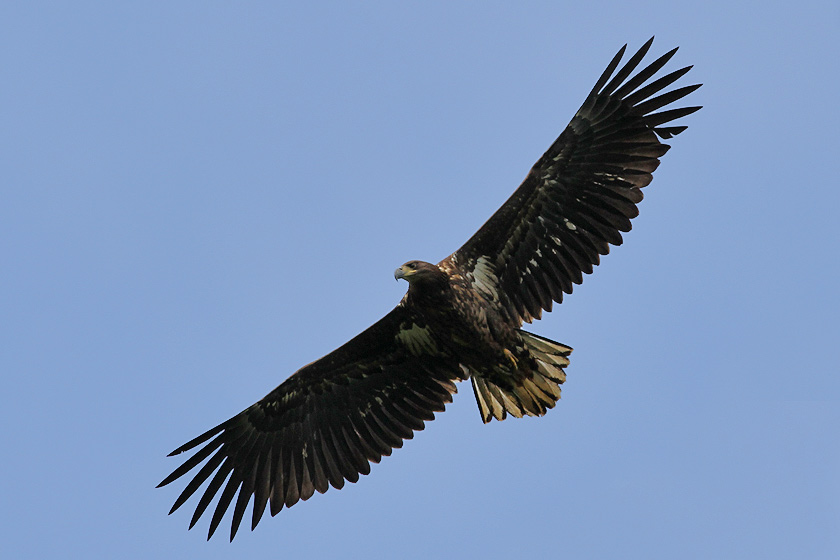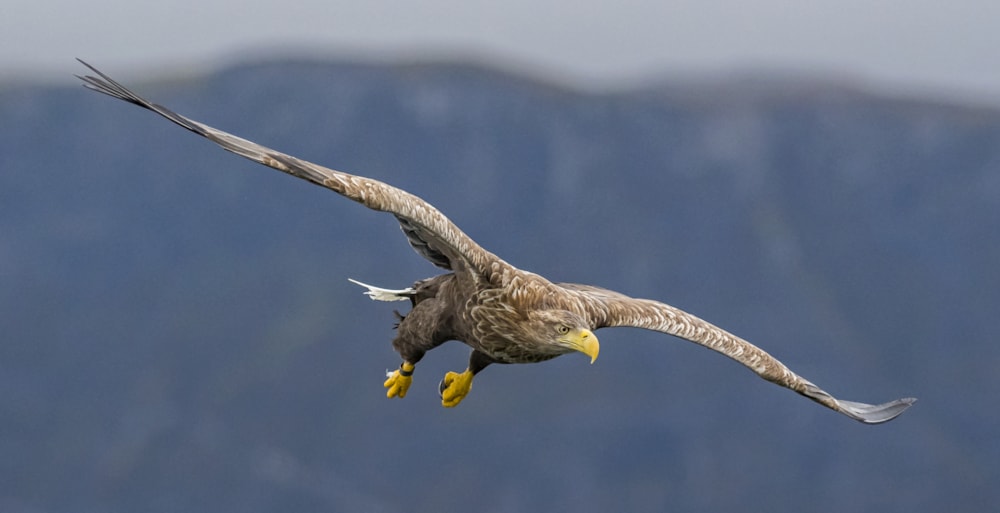Two White-tailed Eagles disappear over Scottish grouse moors
RSPB Scotland is appealing for information after two young satellite-tagged White-tailed Eagles disappeared in highly suspicious circumstances.
Transmissions from the tags of both birds ceased on 22 July 2019. One was last recorded over a grouse moor in Inverness-shire, and the other over a grouse moor in Aberdeenshire.
The Inverness-shire grouse moor is in an area with a history of bird of prey persecution, including numerous suspicious disappearances of tagged Golden Eagles over several years. These incidents led the Scottish Government to commission an independent review in 2016 into the fates of satellite-tagged in Scotland, with the subsequent report finding that a third of these birds had most likely been illegally killed.
The birds that disappeared in July were both chicks born to breeding pairs making up the reintroduced White-tailed Eagle population in east Scotland, which remains tiny. The reintroduction project ran between 2007 and 2012 and was conducted by RSPB Scotland, Forestry Commission Scotland and Scottish Natural Heritage. Illegal persecution lead to White-tailed Eagles becoming extinct in Scotland in 1918.

The White-tailed Eagles that went missing were both immatures, born in 2016 and 2018 respectively (Stephen Daly).
Ian Thomson, RSPB Scotland's Head of Investigations, said: "Yet again, rare, protected birds of prey have disappeared in highly suspicious circumstances, with their last known locations on grouse moors. And yet again, we can be almost certain that these birds have been killed, with those responsible destroying all the evidence. The disappearance of these two eagles is more than a loss of two birds; it means any future breeding success they might have had, helping to boost the numbers of these rare birds, has also been destroyed. Illegal persecution is seriously undermining the re-establishment of a White-tailed Eagle population in this part of Scotland."
Satellite-tagging technology allows conservationists to monitor eagles as they establish and develop a breeding population following the reintroduction, as well as providing insight into the threats they face and how best to help them. The tags, designed to transmit regularly, even after a bird has died, are fitted by licensed, trained fieldworkers. RSPB Scotland was monitoring the eagles' tag data and, in both cases, they suddenly ceased transmitting, with no prior evidence of any technical issues.
The National Wildlife Crime Unit and Police Scotland were immediately notified and, under routine procedure, were provided with the tags' data to allow them to make a separate independent assessment of the birds' likely fates. Follow-up investigations by the police, including searches of the final known locations of the birds, have yielded no further information as to their likely demise. Neither bird, nor their transmitters, have been seen or heard from subsequently, strongly suggesting that they have been illegally killed.
Ian Thomson continued: "In 1999, Donald Dewar, Scotland's first First Minister, described raptor persecution as a "national disgrace", but 20 years on, it continues unabated. It's clear that current legal deterrents aren't working and is long overdue that the stain of raptor persecution was removed from our nation's reputation by the introduction of robust regulation of a driven grouse shooting industry that is blighting our country's incredible wildlife and contributing to its biodiversity crisis."

White-tailed Eagle has little more than a toehold in eastern Scotland, and the loss of two young birds to shooting is a major blow for the population (Martyn Jones).
'White L' was a male eagle tagged as a chick at a nest in in Fife in 2016. His tag last transmitted on a grouse moor a few miles from the famous Banchory to Fettercairn Road, in Aberdeenshire. The other chick fledged from a nest in Inverness-shire in 2018 and disappeared on managed moorland near Tomatin in the northern Monadliaths. As well as repeated disappearances of satellite-tagged eagles, this area of Inverness-shire has seen numerous incidents of shooting, poisoning and illegal trapping of eagles, Red Kites and Hen Harriers.
The independent peer-reviewed report which followed the Scottish Government commissioned review of the fates of satellite tagged eagles provided unequivocal evidence of the link between the highly suspicious disappearance of satellite-tagged raptors and criminal activity associated with grouse moor management.
Anyone with information about either of these birds or any other wildlife crime is urged to contact Police Scotland on 101 or call the RSPB's raptor crime hotline on 0300 999 0101.

